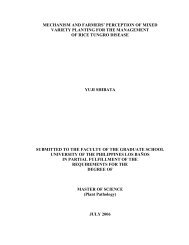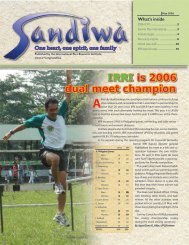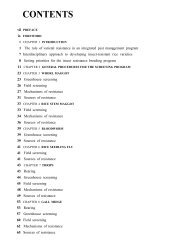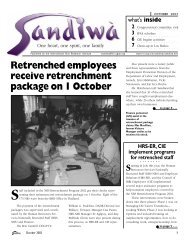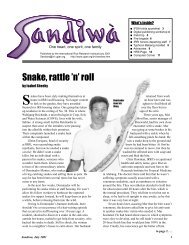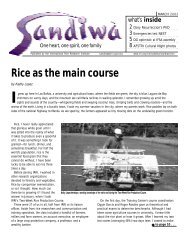Untitled - International Rice Research Institute
Untitled - International Rice Research Institute
Untitled - International Rice Research Institute
You also want an ePaper? Increase the reach of your titles
YUMPU automatically turns print PDFs into web optimized ePapers that Google loves.
Identification of fungi detected on rice seed<br />
The standard detection method used in identifying<br />
fungi on rice seed at IRRI is given below. Figure 3<br />
shows the parts of a rice seed attacked by fungi.<br />
With this method, numerous fungi have been detected<br />
on rice seed. The profile of each fungus detected<br />
is presented in the following pages.<br />
Methods and conditions of rice seed incubation<br />
for microorganism detection are listed below.<br />
The <strong>International</strong> Rules for Seed Testing recommend<br />
the blotter test for detecting seedborne fungi.<br />
The procedure involves these steps:<br />
1. Prepare materials (9.5-cm plastic petri dish,<br />
marking pencil, round blotter paper, distilled<br />
water, sampling pan, forceps, seed sample).<br />
2. Label plates accordingly using a marking<br />
pencil.<br />
3. Place 2–3 pieces of moistened round blotter<br />
paper in labeled plastic petri dishes.<br />
4. Sow 25 seeds per plate making sure that<br />
seeds are sown equidistantly with 15 seeds on<br />
the outer ring, 9 seeds at the inner ring, and 1<br />
seed in the middle.<br />
5. Incubate seeded plates at 21 °C under a 12-h<br />
light and 12-h dark cycle. Light sources can<br />
be near ultraviolet (NUV) light or daylight<br />
fluorescent tubes. The NUV light source can<br />
be a 320–400 nm lamp, preferably Philips<br />
TLD 36W/08 or GE F 40 BL. Daylight fluorescent<br />
tubes can be Philips TL 40W/54 day<br />
light or its equivalent.<br />
6. Examine each of the seeds after 5–7 d of<br />
incubation for fungal growth.<br />
Partition between<br />
lemma and palea<br />
Lemma<br />
Awn<br />
Sterile lemmas<br />
Palea<br />
Fig. 3. Parts of a rice seed.<br />
13



